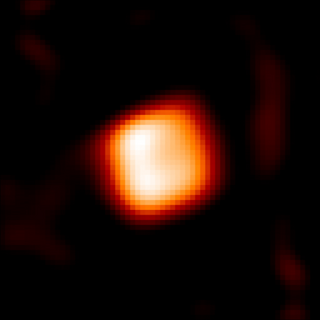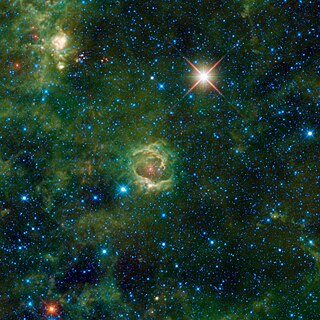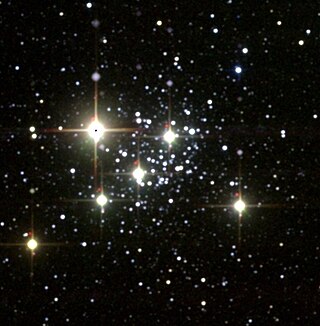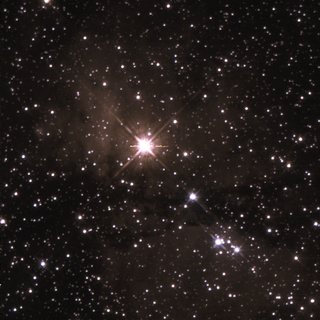
Red supergiants (RSGs) are stars with a supergiant luminosity class and a stellar classification K or M. They are the largest stars in the universe in terms of volume, although they are not the most massive or luminous. Betelgeuse and Antares A are the brightest and best known red supergiants (RSGs), indeed the only first magnitude red supergiant stars.

Mu Cephei, also known as Herschel's Garnet Star, Erakis, or HD 206936, is a red supergiant or hypergiant star in the constellation Cepheus. It appears garnet red and is located at the edge of the IC 1396 nebula. Since 1943, the spectrum of this star has served as a spectral standard by which other stars are classified.

VV Cephei, also known as HD 208816, is an eclipsing binary star system located in the constellation Cepheus, approximately 3,300 light years from Earth. It is both a B[e] star and shell star.

KY Cygni is a red supergiant of spectral class M3.5Ia located in the constellation Cygnus. It is approximately 4,700 light-years away.

Phi Cassiopeiae is a multiple star in the constellation Cassiopeia with a combined apparent magnitude of +4.95. The two brightest components are A and C, sometimes called φ1 and φ2 Cas. φ Cas A is an F0 bright supergiant of magnitude 4.95 and φ Cas C is a 7.08 magnitude B6 supergiant at 134".
KW Sagittarii is a red supergiant star, located approximately 2,160 parsecs away from the Sun in the direction of the constellation Sagittarius. It is one of the largest known stars, with a diameter about 1,000 times larger than the Sun. If placed at the center of the Solar System, the star's surface would engulf Mars, coming close to Jupiter's orbit.

V354 Cephei is a red supergiant star located within the Milky Way. It is an irregular variable located over 13,000 light-years away from the Sun. It has an estimated radius of 1,139 solar radii. If it were placed in the center of the Solar System, it would extend to between the orbits of Mars and Jupiter.

HD 74180 is a single star in the constellation Vela. It is a yellow-white F-type supergiant with a mean apparent magnitude of +3.81 and a spectral classification F8Ib. Estimates of its distance to Earth vary between 3,200 and 8,300 light-years.

S Persei is a red supergiant or hypergiant located near the Double Cluster in Perseus, north of the cluster NGC 869. It is a member of the Perseus OB1 association and one of the largest known stars. If placed in the Solar System, its photosphere would engulf the orbit of Jupiter. It is also a semiregular variable, a star whose variations are less regular than those of Mira variables.

RW Cephei is a K-type hypergiant and a semirregular variable star in the constellation Cepheus, at the edge of the Sharpless 132 H II region and close to the small open cluster Berkeley 94. It is among the largest stars known with a radius of almost 1,000 times that of the Sun (R☉), nearly as large as the orbit of Jupiter.

WOH G64 is an unusual red supergiant (RSG) star in the Large Magellanic Cloud (LMC) satellite galaxy in the southern constellation of Dorado. It is one of the largest known stars, being described as possibly being the largest star known. It is also one of the most luminous and massive red supergiants, with a radius calculated to be around 1,540 times that of the Sun (R☉) and a luminosity around 282,000 times the solar luminosity (L☉).

PZ Cassiopeiae is a red supergiant star located in the constellation of Cassiopeia, and a semi-regular variable star.

UY Scuti (BD-12°5055) is a red supergiant star, located 5,900 light-years away in the constellation Scutum. It is also a pulsating variable star, with a maximum brightness of magnitude 8.29 and a minimum of magnitude 10.56, which is too dim for naked-eye visibility. It is considered to be one of the largest known stars, with a radius estimated at 909 solar radii, thus a volume of 750 million times that of the Sun. This estimate implies if it were placed at the center of the Solar System, its photosphere would extend past the orbit of Mars or even the asteroid belt.

Westerlund 1 W26 or Westerlund 1 BKS AS is a red supergiant located at the outskirts of the Westerlund 1 super star cluster. It is one of the largest known stars and the most luminous supergiant stars discovered so far with radius calculated to be in excess of a thousand times the solar radius, and a luminosity of over 200,000 times the solar luminosity. If placed at the center of the Solar System, its photosphere would engulf the orbit of Jupiter.
IRC −10414 is a red supergiant and runaway star in the constellation Scutum, a rare case of a red supergiant with a bow shock.

RS Persei is a red supergiant variable star located in the Double Cluster in Perseus. The star's apparent magnitude varies from 7.82 to 10.0, meaning it is never visible to the naked eye.

NGC 7419 is an open cluster in the constellation Cepheus. It is heavily reddened and notable for containing five red supergiants, the highest number known in any cluster until the end of the 20th century, but probably no blue supergiants.

Stephenson 2 DFK 1, also known as RSGC2-01 or St2-18, is a red supergiant (RSG) or possible extreme red hypergiant (RHG) star in the constellation of Scutum. It lies near the open cluster Stephenson 2, which is located about 5.8 kiloparsecs away from Earth in the Scutum–Centaurus Arm of the Milky Way galaxy, and is assumed to be one of a group of stars at a similar distance, although some studies consider it to be an unrelated or foreground red supergiant. It is potentially among the largest known stars, one of the most luminous red supergiants, and one of the most luminous stars in the Milky Way.

Westerlund 1-237 or Westerlund 1 BKS B is a possible red supergiant (RSG) in the constellation of Ara. It is one out of four known red supergiants in the Westerlund 1 super star cluster, although its outlying position, spectrum, and parallax, suggest it could be a foreground giant. As a red supergiant, it would be one of the largest known stars and one of the most luminous of its type.

WOH S264 is a large, highly luminous red supergiant star similar to Betelgeuse in the Large Magellanic Cloud.



















